PETRIFIED FOREST (Day 6 - part 3)
We continued our drive south toward the other end of the park.


These hills are made up of the oldest rocks of the Chinle Formation called the Mesa Redondo Member. The layers represent floodplain deposits.

These formations are called the Tepees.

Jasper Forest (originally called First Forest since it was the first stop visitors made in the early 1900's) contains one of the largest accumulations of petrified wood in the world. As the softer bluffs eroded, the harder petrified wood is exposed.
This is only a small portion of what was originally there. The area was plundered in the late 19th and early 20th century by commercial collectors to sell as souvenirs. The nearby train also provided early travelers an easy way to take as much as they wanted.

An overview of the area

Chunks of petrified wood lay strewn about.
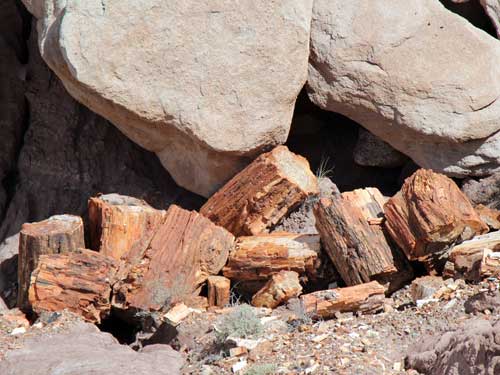

Then and now... some sections still remain intact.

Hard to spot, this bird closely matches the color of its surroundings.

This is possibly a Plateau Fence Lizard.
Crystal Forest gets its name from the beautiful crystals that can be found in some of the petrified logs. We did a short stroll up to a covered viewpoint.


Unfortunately this is still a common problem.
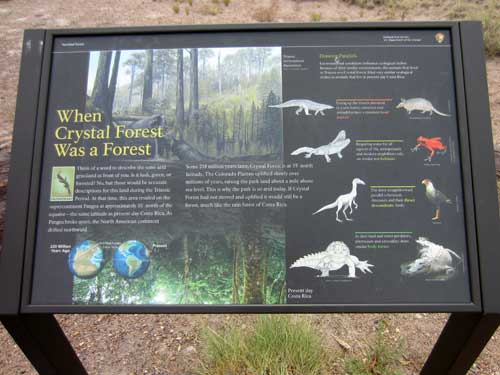
How does wood become rock?
Back some 200 million years ago during the late Triassic, when the Chinle layer was being formed, this area was located near the equator, on the edge of Pangaea not too far from the ocean. It was lush and tropical, with 200-foot trees and giant ferns.

This area once sat where Costa Rica now sits. As it migrated north and was lifted up on the Colorado Plateau, it became much drier.
As trees died or were knocked down, rivers carried them downstream, breaking off branches and roots along the way. Many of the trunks washed up on the river banks while others became buried in the stream channels. Most of them decomposed and disappeared. But some of them became buried by sediment before they could decompose. Meanwhile, volcanoes in the west spewed forth tons of ash, which mingled into the sediments. Ground water dissolved the silica from the volcanic ash and carried it through the logs. Over lots of time, this solution filled the cells and crystalized as a mineral quartz. Iron and other minerals combined with the quartz during this petrification process, creating brilliant colors.
How long does the petrification process take? it depends on the environmental conditions, such as burial rate and the amount of silica in the groundwater. The initial stages may only take decades but it takes millions of years for the silica's molecular changes to result in colorful crystalline quartz. The logs buried here had petrified by the time T. rex walked the land some 135 million years later.

How a tree turns to a petrified wood

The different colors were caused by the presence of different minerals.

The settling of a heavy quartz log caused cracks and eventually breaks. The logs break perpendicular to their length because that is the shortest distance for a crack to grow... similar to a brittle piece of chalk.

Nine differed species of fossil trees have been identified in the park... all of them now extinct.


It certainly looks like wood!



Our final stop was the Rainbow Forest.

This was the original park headquarters from 1906 to 1962. Although back in the 1920's, it was still just a tar paper building.

Never pass up a good opportunity!
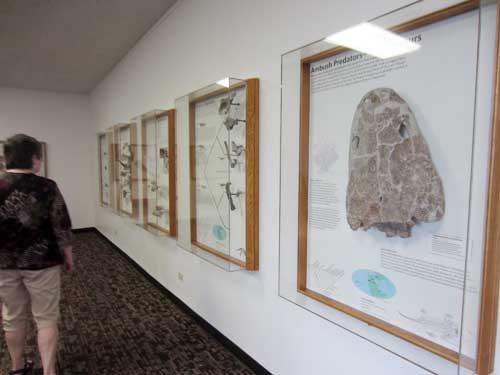
So much information!
Who lived in this lush forest some 223 million years ago? While many animals of the late Triassic looked like dinosaurs (thanks to convergent evolution), they were more closely related to crocodiles. Actually, dinosaurs were only just starting to appear on the scene.

In the foreground is the skeleton of Placerias hesternus. This was a large reptile that had many mammalian characteristics.

Placerias was one of the largest herbivores of the time.

Rauisuchids differed from dinosaurs in that they had a more upright posture, with their legs tucked beneath their body. But for the most part, they were so similar to dinosaurs that it is difficult to differentiate them without the right bones... such as an ankle, pelvis or femur (for the pelvic socket).

They certainly look like dinosaurs to me!

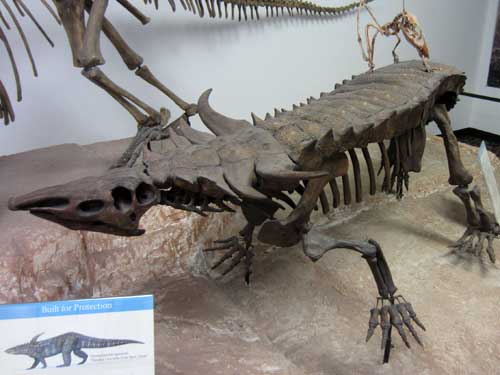
Aetosaurs were long, omnivorous reptiles with protective plates.

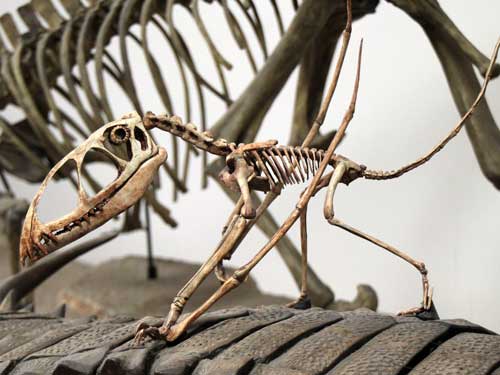
The Dimorphodon was a pterosaur, a flying reptile whose wing was comprised of one long finger and a flap of skin.

The late Triassic... huge conifers, tree ferns, massive amphibians, enormous crocodile-like animals and the earliest dinosaurs.The Triassic was also the age of the first pterosaurs, turtles and true mammals.

In the 1930's, a fossil phytosaur skull was found with bite marks on its nose, apparently made by another phytosaur. That discovery led to the making of this diorama, completed in 1936 and considered the first serious reconstruction of a Triassic landscape. Some of the ferns were dipped in acid or covered with melted beeswax to give a more natural texture. The mud was a mixture of wax and earth and molded with hot tools. Other materials were waxed crepe paper, turkey quills, plaster of Paris, abestos, and even real plants that were preserved with glycerin and alcohol.

Ouch! Play nice! Despite their similarities in appearance and lifestyle, phytosaurs were different from true crocodiles. During the Triassic, there were found almost everywhere on the globe. Their name means "plant reptile" since the first fossils were mistakenly thought to belong to plant eaters.

The raised paths in the pieces of petrified wood are insect burrows. The light brown material is fossil wood cells and the dark brown is... ancient insect excrement! Yup, 200 million year old bug poop!
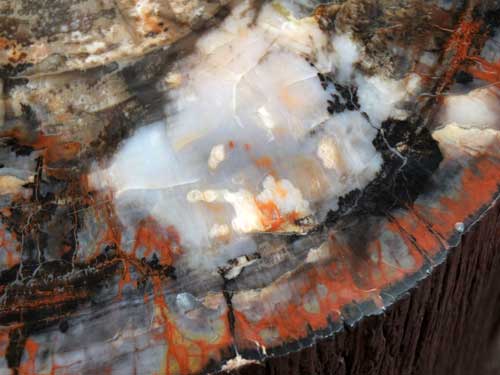
A piece of polished petrified wood
The Giant Logs trail started just outside.




Old Faithful is 35 feet long, has a base about 10 feet across, and weighs an estimated 44 tons. Back in 1962, it was struck by lightning that caused substantial damage. At the time, the National Park Service added the cement base to try to save it.
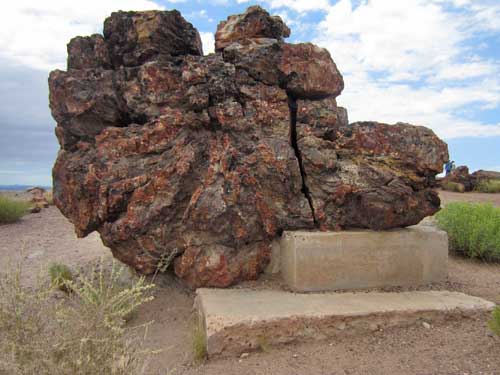
The roots and branches broke off either during the log's journey downstream or after fossilization and exposure.





Cracks in the logs allowed the quartz crystals to grow larger, leading to beautiful purple amethyst, yellow citrine and smoky quartz.

A storm looms in the distance
return • continue

